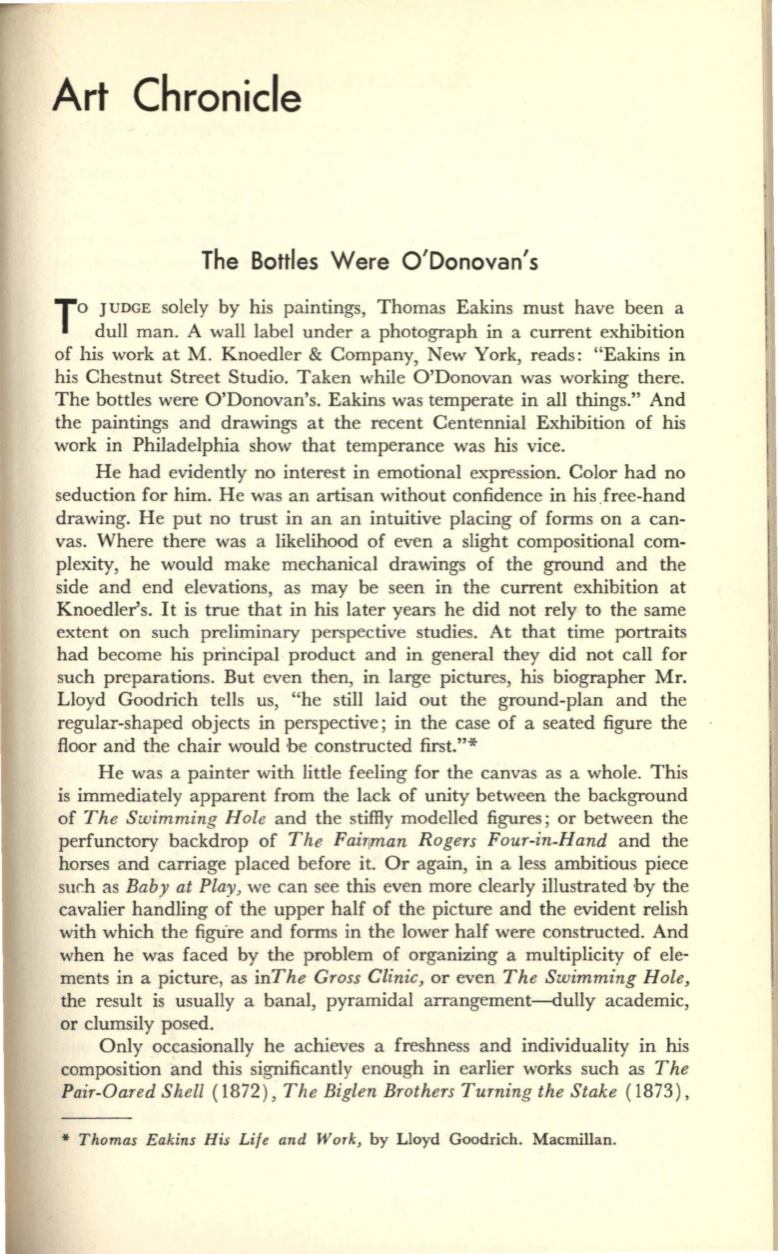
Art Chronicle
The Bottles Were O 'Donovan's
T
o
JUDGE
solely by his paintings, Thomas Eakins must have been a
dull man. A wall label under a photograph in a current exhibition
of his work atM. Knoedler
&
Company, New York, reads: "Eakins in
his Chestnut Street Studio. Taken while O'Donovan was working there.
The bottles were O'Donovan's. Eakins was temperate in all things." And
the paintings and drawings at the recent Centennial Exhibition of his
work in Philadelphia show that temperance was his vice.
He had evidently no interest in emotional expression. Color had no
seduction for him. He was an artisan without confidence in his .free-hand
drawing. He put no trust in an an intuitive placing of forms on a can–
vas. Where there was a likelihood of even a slight compositional com–
plexity, he would make mechanical drawings of the ground and the
side and end elevations, as may be seen in the current exhibition at
Knoedler's.
It
is true that in his later years he did not rely to the same
extent on such preliminary perspective studies. At that time portraits
had become his principal product and in general they did not call for
such preparations. But even then, in large pictures, his biographer Mr.
Lloyd Goodrich tells us, "he still laid out the ground-plan and the
regular-shaped objects in perspective; in the case of a seated figure the
floor and the chair would be constructed first."*
He was a painter with little feeling for the canvas as a whole. This
is immediately apparent from the lack of unity between the background
of
The Swimming Hole
and the stiffly modelled figures; or between the
perfunctory backdrop of
The Fair1man Rogers Four-in-Hand
and the
horses and carriage placed before it. Or again, in a less ambitious piece
sur.h as
Baby at Play,
we can see this even more clearly illustrated by the
cavalier handling of the upper half of the picture and the evident relish
with which the figu·re and forms in the lower half were constructed. And
when he was faced by the problem of organizing a multiplicity of ele–
ments in a picture, as
inThe Gross Clinic,
or even
The Swimming Hole,
the result is usually a banal, pyramidal arrangement-dully academic,
or clumsily posed.
Only occasionally he achieves a freshness and individuality in his
composition and this significantly enough in earlier works such as
The
Pair-Oared Shell
(
1872),
The Biglen Brothers Turning the Stake
(
1873),
*
Thomas Eakins His Life and Work,
by Lloyd Goodrich. Macmillan.


